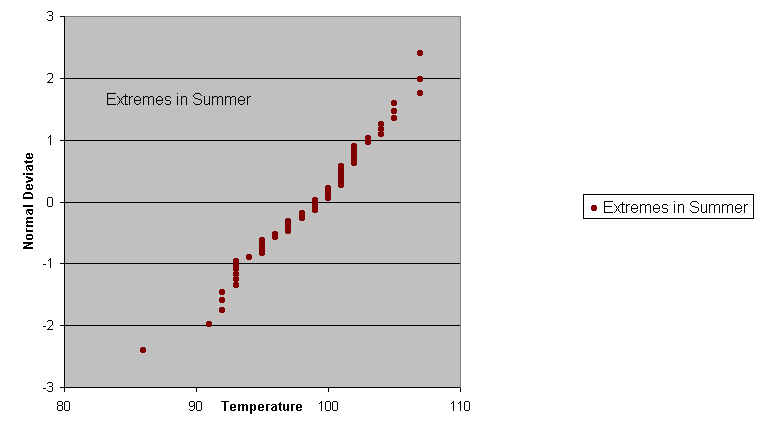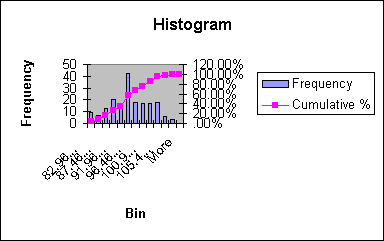
WSU STAT 360 Autumn 2000
Class Session 5 Summary and Notes
The motivation for this particular class is to illustrate the source of common distributions. In Vining's book they seem to just fall from the sky onto our page. I wanted to illustrate how each is derived from another, and that they all build upon a few simple, but powerful ideas in probability.
At this point I have introduced all of the discrete and continuous distributions that we use in this introductory class. Next class period we will work examples which show the utility of most of them. The rest will have to wait until we begin chapter 4 where we draw inferences from our statistics.
An example calculation of expected value of a function
Recall that E(y) = S yp(y) for a discrete RV and V(y)=E(y²)-[E(y)]²
If it is not y that we wish to find an expectation value for, but a function of y, like Q=g(y), instead, then
E(Q)=E(g(y))=Sg(y)p(y)
Consider the following problem. A capacitor is charged in a circuit through a resistor. Thus, voltage as a function of time is V=Vo(1-e-at). The capacitor can be discharged through a switch that has some probability of closing at each tick of a clock. Therefore the closing of this sampling circuit follows a geometrical distribution; p(r)=pqr-1. From this information we would like to calculate the expected charge transferred per closing of the sample circuit. From the definition of capacitance Q=CV. Thus at each clock tick after a complete discharge the amount of charge transferred to the capacitor is...
Q(r)=CVo(1-e-ar). E(Q) = SQ(r)p(r).
The following spreadsheet shows the calculation of E(Q) and V(Q) assuming that p=0.25. Please excuse the excessive accuracy.
Example Problem
p=0.25 V=10volts C=10e-6f time constant=0.5sec
time step(n) p Q(n) p(n)*Q(n) p*Q(n)2 p(n)*n
1 0.25 3.93469E-05 9.83673E-06 3.87045E-10 0.25
2 0.1875 6.32121E-05 1.18523E-05 7.49206E-10 0.375
3 0.140625 7.76870E-05 1.09247E-05 8.48709E-10 0.421875
4 0.10546875 8.64665E-05 9.11951E-06 7.88532E-10 0.421875
5 0.079101563 9.17915E-05 7.26085E-06 6.66484E-10 0.39550781
6 0.059326172 9.50213E-05 5.63725E-06 5.35659E-10 0.35595703
7 0.044494629 9.69803E-05 4.31510E-06 4.18480E-10 0.31146240
8 0.033370972 9.81684E-05 3.27598E-06 3.21597E-10 0.26696777
9 0.025028229 9.88891E-05 2.47502E-06 2.44752E-10 0.22525405
10 0.018771172 9.93262E-05 1.86447E-06 1.85191E-10 0.18771171
11 0.014078379 9.95913E-05 1.40208E-06 1.39635E-10 0.15486216
12 0.010558784 9.97521E-05 1.05326E-06 1.05065E-10 0.12670540
Sums 0.968323648 6.90172E-05 5.39036E-09 3.49317836
E(Q)= 6.90172E-05Coulombs
V(Q)= 6.26976E-10
Std.Dev=2.50395E-05Coulombs
By comparison the calculation of E(Q) as E(n) substituted into the
expression for Q(n) is 8.25632E-05 Coulomb which is 14% too high.
Back to the subject of extreme values.
We can write down the probability associated with a maximum value as follows.
P(X1=m,X2<=m,...,Xk<=m)=Probability of k items <=m.We assume the samples are random and independent, and make use of the cumulative distribution ,Cdf(x). By definition then...
P(X1=m,X2<=m,...,Xk<=m)=Cdf(m)*Cdf(m)*...*Cdf(m) or, equivalently P(X1=m,X2<=m,...,Xk<=m)=Cdf(m)k
Once again, this distribution is of the extreme value, and I mentioned that it is of great importance in engineering work. Now I will show you its importance. Often engineers design things to withstand unusual events. No doubt all of you have heard of the 100 year flood, or the 100 year wind gust, or whatever. Most people think of this as the greatest such event that will occur in 100 years, but this terminology leads people to think that such an event can happen only once in a hundred years. This is wrong thinking.
A better way to frame this is that the 100 year wind gust is an event that will happen once per 100 years on average if we examine a long enough historic record. In this sense the 100 year wind could occur in two successive years, but only on rare occasions. How rare is what we want to decide.
First, before we go very far into this discussion, I must provide one caveat. The distribution on which we base all this work assumes that samples of extreme whatever are independent samples. It is on this assumption that all our proud work may run aground. Obviously if we are examining wind gusts from day to day, then very windy days occur together. Thus the high wind gust on tuesday, for instance, is NOT independent of the gust on monday. They are correlated by the fact that storminess occurs over several days. Unfortunately this tendency occurs on longer time scales.
Beniot Mandelbrot showed that correlation, or lack of independence, occurs over the longest time scales imaginable in geophysical data. Windy days cluster together, as do windy years, and windy centuries and so forth. Mandelbrot has called this the "Joseph" effect for the prophet who foresaw lean years following years of plenty. Please keep in mind that geophysical data may not behave like random, independent samples, no matter how far apart in time they occur.
Second, also before we go too far, I need to define the return interval of an event. If an event has a probability of p of occuring during a sample interval, then it has a return interval T=1/p periods. For example, the odds of snake-eyes on the roll of two die is 1/36, so the return interval is 36 rolls. However, snake-eyes can turn up on two consecutive rolls.
One way to approach the problem of estimating probabilities and return periods is to simply look at whatever historical record one has, and estimate from the frequency of actual observations. There are two disadvantages in this. The most important is that it only provides an estimate of the greatest event so far observed. What of even larger events? Also, it leaves us to estimate using only a few events, maybe only one. We need a method for using all the available data, not just a few observed extremes.
The distribution of extreme values depends on the Cdf, which we can estimate very well using all our observed data. Then we make use of the distribution of the extreme Cdf(m)k to extrapolate to events greater than any observed so far. So we have already derived all the tools we need to solve our problem. Let's look at real data to illustrate the method.
I have obtained daily temperature records for Portland for the period 1928-1996. The spreadsheet, which I have included on another web-page, shows the maximum temperatures recorded during the three summer months, June, July, and August. The record extreme temperature is 107F, and it occurred thrice in the 62 years of record. So the return interval of 107F temperature is roughly 21 years. Amazingly enough, these records occurred in 1941, 1964, and 1981; just about 20 years apart. This makes me terribly suspicious about long range correlation in the data, but we'll use it as an example just the same.
The next figures show probability plot of the data for the entire summer, and for the month of August. Vining would say that these plots show the data to be nearly normal, but I'm not so sure, especially after examining a histogram of the summers data.

Indeed, the histogram below shows that the distribution of extreme temperatures for each month (3 per each summer) follow a skewed distribution that is probably unimodal, but definitely not normal.

The probability plot for just the month of August looks only slightly more like a normal distribution. Extreme values, even if drawn from a process that is normal, are themselves not normal.

At this point we would like to find a more reasonable model distribution, which would allow a better extrapolation to events of longer return periods. Then we can use this information to make a design specification. I will leave that for the next class period, however. These notes have become too long already.
Notes: This is the list of miscellaneous stuff that is meant to distract you from the dreariness of statistics.
s2y = S(y-y')2/(n-1); where y' is the sample mean.
It is sometimes more convenient to use this formula expanded to...
s2y = ( (Sy2) - ny'2 )/(n-1)
Link forward to the next set of class notes for Friday, October 6, 2000